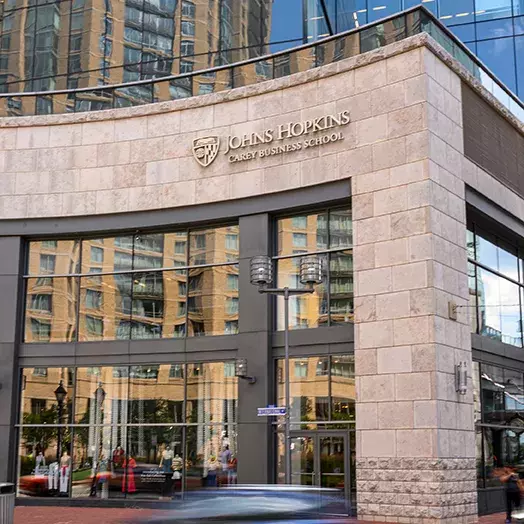Institutional investors in private equity are getting shortchanged, says Jeff Hooke, a Carey Business School senior lecturer and expert in finance and investment banking.

The Private Equity Business is “Not All It’s Cracked Up to Be”
Article Highlights
- A “protective ecosphere” of investors, regulators, investment consultants, and the business media perpetuates the myth that private equity funds are better than investing in the stock market.
- Private equity returns over the last 15 years have been mediocre, just barely matching or falling behind stock market indexes.
- Despite being a multitrillion dollar business, the industry lacks transparency and accountability.
According to Johns Hopkins Carey Business School Senior Lecturer Jeffrey C. Hooke, private equity (PE) “is a current manifestation of the irrationality that grips Wall Street from time to time.” The PE industry maintains a certain mystique, he says, because the lack of public information about it blocks the scrutiny that public equity markets receive. Private equity firms and fund managers claim their investments provide better returns than the stock market. But is this true?
In his latest book, The Myth of Private Equity: An Inside Look at Wall Street's Transformative Investments, Hooke compares today’s private equity mania to the internet stock boom of the late 1990s and the mortgaged-backed securities craze that led to the 2008-2009 financial crisis. He explains the foundation for PE and why, despite the industry’s downward trend of late, a “protective ecosphere” allows it to continue, to the detriment of its investors and their beneficiaries. In the following Q&A, the author explains the book’s central themes and why he felt he had to write it.
What is private equity?
Private equity is an asset class for investing in companies not listed on a stock exchange. PE firms like Blackstone, KKR, and Carlyle-to name a few-obtain capital from large institutions such as public pension funds, university endowments, and charitable foundations. The PE funds—which typically have a 10-year life—are run by investment bankers, with a sprinkling of management consultants. The funds buy privately held companies and then try to improve and sell them, all within the 10-year window. The sequence of events resembles “house flipping.”
How do private equity firms make money?
PE firms make a profit from yearly management fees (paid by their institutional investors). If the firms sell a company that has improved in value, they get a piece of the profit. The fees add up to 3 or 4 percent of annual asset value, which is much more than what you pay for public mutual funds. Most of the fees are paid whether the underlying funds achieve good results, and the PE funds put up very little of their own money to participate in the profits. It does not get any better than that on Wall Street. Many people confuse PE funds with their distant cousin, hedge funds. Hedge funds also pool capital and invest it, but hedge funds trade mostly in publicly traded stocks and bonds, not private companies.
So, what are some of the problems with private equity?
PE paints itself as the greatest thing since sliced bread, but its big marketing claim—that its returns crush the public stock market—is patently false. In fact, the returns over the last 15 years have been quite mediocre, either just matching the stock market or falling below it.
Since 2010, PE funds have not sold over half of their investments. Unlike public stocks that are priced daily, investors must rely on what the PE funds say these unsold investments are worth. So, basically, the PE industry grades its own homework.
PE’s premium returns tend to be produced only in the top quartile of funds, yet up to 75 percent of funds insist they are in the top quartile. The industry is a real-life version of Garrison Keillor’s Lake Wobegon, where every child is above average.
The industry is not at all transparent. Even the investors complain about the secrecy. Investigative reporters, investor advocates, and others struggle to obtain accurate information on returns and fees. The industry massages what little information is released to present mediocre returns in favorable light. Sadly, regulatory oversight is absent–there is no sheriff in town–despite PE being a multitrillion dollar business.
So, why do the institutions still invest?
I get that question a lot. Most institutional board of directors are intelligent people but unsophisticated in terms of investments. They leave portfolio choices to the institution’s investment managers, and these managers’ career and compensation interests are not properly aligned with those of institutions’ beneficiaries. Fiduciary obligation thus becomes an abstract concept. I am not the only one saying this.
But surely there’s something good about investing in private equity. Blackstone stock is up 80 percent over 12 months.
Right. PE is a good deal for the managers, like Blackstone. They make big fees whether their underlying funds beat the market or not. However, just to clarify, my book doesn’t focus on public stocks, like Blackstone or Carlyle. My issue is with PE funds run by these firms.
An advantage to owning some private equity is portfolio diversification into unlisted companies. The moderate returns and high fees reduce that advantage.
Industry proponents say private equity is good for America.
PE proponents like to go up to Capitol Hill and say that private equity is good for the country because PE buys ailing companies and rehabilitates them. That notion is a fairy tale, an urban myth. Most PE deals involve a healthy, money-making business that is then loaded with debt. Banks lend money to companies that have a profitable history. Turnarounds do not fit into this category.
How does the myth about private equity persist?
The industry’s protective ecosphere is strong. A coterie of enablers, some unwittingly, foster the myth. Regulators have been absent and afraid to challenge the PE behemoth. Federal and state legislators coddle the business. The accounting profession enacts special PE accounting rules that promote concealment. Consultants, who get paid more to push exotic asset classes, recommend PE instead of higher yielding public stocks. And, of course, as I mentioned, the managers at the customers (i.e., the big institutions) promote PE, since pegging a portfolio to a simple public index is career threatening.
The business media covers the sexy side of the industry-the fund managers, new transactions, and so forth-but does little in depth examination of operating methods, fees imposed, and claims of success. The few who want to investigate the business run up against a brick wall. Other reporters believe writing critical stories cuts off industry access. Who would want to do that?
What to Read Next

student experience
Johns Hopkins Carey Business School MBA Experiential Learning Curriculum Recognized with Annual Innovation AwardWhy did you feel compelled to write an exposé? Has there been any pushback?
As an investment banker, I interacted with private equity firms all the time, and I worked in private investments for many years. I was always skeptical about PE’s claims to genius and great returns. Here at Carey, I co-wrote several academic papers relating to PE. More and more, these claims of greatness seemed untrue. A couple of years ago, a Washington Post reporter wrote a paean to private equity, and I had had enough. I put my foot down and decided that someone needed to expose the business.
I had written a few other books, knew the players, and had access to private equity databases. And, importantly, from a practical perspective, I was a point in my career where I had nothing to lose. I couldn’t be blackballed from Wall Street jobs.
As for pushback, the best strategy for PE is to stay silent. They're making tens of billions a year from questionable investment performance. They’ve got a good thing going; why bring attention to detractors?
Will the Securities and Exchange Commission’s proposed new rules for greater transparency in the private equity industry help address your concerns?
It is known that education in the U.S. is paid for by all: both for Americans and, even more so, for foreign nationals. There are, of course, opportunities for free higher education, too. Both can study for free at any U.S. institution if they receive a sponsorship student loan forgiveness 2022, scholarship, or grant: from the government, private, or from the institution itself. Not all applicants are eligible for such benefits. Nevertheless, it is still necessary to finance education. This is where educational loans come into play in the United States. In the U.S. the practice of giving educational loans to students and their parents has existed for a long time. This form of educational loans is very popular with students and parents. The average U.S. family does not have enough money to cover at least one year of college. Even at the most inexpensive college. And that's not counting the cost of living (if the student is studying in another city), food, books, and other necessities. For international students, these costs are several times higher. Education loans in the United States come in three forms: federal student loans, parent loans, and private loans. Only one of these is available to international students. It is a private loan called the Private International Student Loan.
It’s nice to see the agency waking up after 20 plus years of being missing in action. Curiously, the proposal to require the reporting of data on honest returns and honest fees will go only to existing PE investors, assuming the small army of PE lobbyists can’t derail the proposal. The public and the millions of beneficiaries dependent on the big institutions-that is, the people who don’t work in or understand Wall Street and the DC swamp-will continue to be left in the dark.